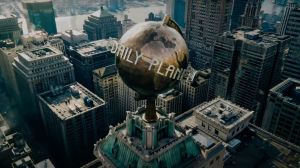WandaVision Episode 4 opened the door to a whole bunch of new reveals – with so much more to come. Titled “We Interrupt This Program,” the fourth chapter explored the world and events outside of Wanda’s (Elizabeth Olsen) bubble of faux sitcom reality, which has taken over the town of Westview. That wider perspective revealed an entirely new division of Marvel peacekeepers (SWORD) at work; some familiar faces from various movie franchises coming together (Jimmy Woo, Darcy Lewis, Monica Rambeau), and some additional explanation of how Wanda is bending reality – and what it could mean for the X-Men’s future introduction into the Marvel Cinematic Universe.
Videos by ComicBook.com
Warning: WandaVision Episode 4 SPOILERS Follow!
In one early scene, WandaVision Episode 4 establishes why none of the locals that lived near and around the town of Westview have sounded the alarm about the strange phenomenon happening in the town. Short answer: Wanda’s conjuring has a ripple effect of making the locals believe there never was a town of Westview.
That detail gets expressed in a scene where FBI agent Jimmy Woo (Randall Park) and SWORD agent Monica Rambeau (Teyonah Parris) encounter local law enforcement outside the town border of Westview, and Wanda’s bubble. The cops have no idea why the feds are looking for a town that doesn’t exist, despite standing next to the Westview town sign. As far as the sheriffs are concerned, they’re from the town of Eastview, and that’s all there’s ever been.
So what does this have to do with the X-Men? Simply put: WandaVision is a small-scale version of what Wanda could eventually do to the entire MCU. And that is exactly how Marvel Studios could solve its X-Men continuity problem.
Right now, Kevin Feige and co. have a challenge: bring the X-Men and the concept of mutants into the MCU, while explaining either why we’ve never seen them until now, or why they’ve never existed before now. That challenge is complicated by the fact that elements of Fox’s X-Men movie franchise (namely, Ryan Reynolds’ Deadpool franchise) are being brought into the MCU. The Post-Avengers: Endgame MCU is exploring the multiverse theory and reality-warping as central concepts. That makes it seem more and more likely that the X-Men reboot could be tied to ideas of alternate realities, which would also preserve Fox’s X-Men films in some kind of bubble, but allow for new interpretations.
Which brings us back to WandaVision Episode 4. The idea that Wanda’s reality-warping power also affects the memories of anyone directly related to the change is key. Fans are rallying behind the theory that WandaVision will end with a “Reverse House of M” event – a play on a Marvel Comics storyline. In the comics, Wanda’s breakdown inside a faux reality led to her erasing mutants from the Marvel Comics Universe. Theory is the MCU will see Wanda wishing the opposite way, warping reality to create a new world populated with mutants.

WandaVision opens the door for Wanda’s “Reverse House of M” to change the world – and the memories of everyone in it. Mutants appearing in the MCU timeline wouldn’t be a big continuity issue, and Marvel Studios would be free to pick and choose which pieces of Fox’s continuity they wanted to incorporate, without fan chat threads stressing about continuity issues. The continuity of the MCU X-Men and Mutant race wouldn’t be “real” enough to contradict events of The Infinity Saga in Phases I – III, but real enough in the minds of the characters to make the X-Men an immediate part of the MCU saga.
Of course, films like Spider-Man 3 and Doctor Strange in the Multiverse of Madness hint that some Marvel characters with heightened perceptions (like Doctor Strange or Spider-Man) could still sense that reality is off. That could pave an easy road for an X-Men vs. Avengers collision, further down the road.









